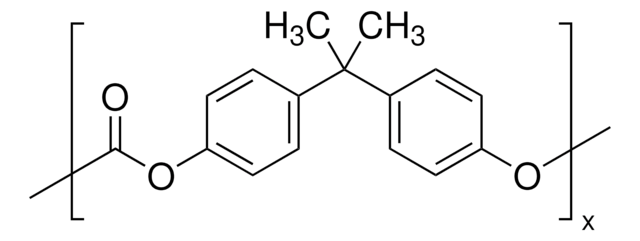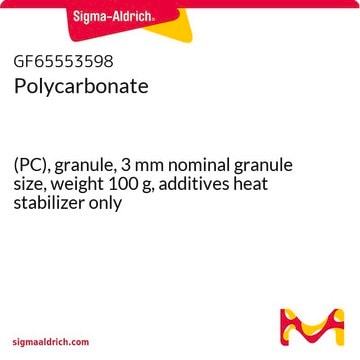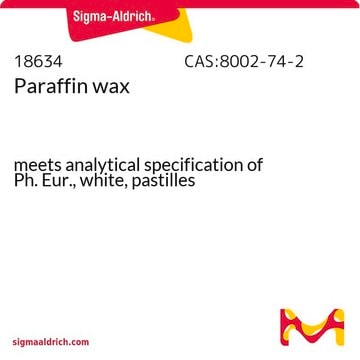If this product has an expiration or retest date, it will be shown on the Certificate of Analysis (COA, CofA). If there is no retest or expiration date listed on the product's COA, we do not have suitable stability data to determine a shelf life. For these products, the only date on the COA will be the release date; a retest, expiration, or use-by-date will not be displayed.
For all products, we recommend handling per defined conditions as printed in our product literature and website product descriptions. We recommend that products should be routinely inspected by customers to ensure they perform as expected.
For products without retest or expiration dates, our standard warranty of 1 year from the date of shipment is applicable.
For more information, please refer to the Product Dating Information document: https://www.sigmaaldrich.com/deepweb/assets/sigmaaldrich/marketing/global/documents/449/386/product-dating-information-mk.pdf
181625
Poly(Bisphenol A carbonate)
average Mw ~45,000 by GPC
Synonyme(s) :
4,4′-Dihydroxydiphenyl-2,2-propane carbonate polymer, Bisphenol A carbonate homopolymer, Carbonic acid-4,4′-dihydroxydiphenyl-2,2-propane copolymer, Poly(dian carbonate), Poly[2,2-bis(4-hydroxyphenyl)propane carbonate]
Sélectionner une taille de conditionnement
239,00 $
Sélectionner une taille de conditionnement
About This Item
239,00 $
Produits recommandés
Poids mol.
average Mw ~45,000 by GPC
Niveau de qualité
Indice de réfraction
n20/D 1.585
Température de transition
Tg 150 °C
Tm 267 °C
Densité
1.2 g/mL at 25 °C (lit.)
Chaîne SMILES
CC(C)(c1ccc(O)cc1)c2ccc(O)cc2
InChI
1S/C15H16O2.CH2O3/c1-15(2,11-3-7-13(16)8-4-11)12-5-9-14(17)10-6-12;2-1(3)4/h3-10,16-17H,1-2H3;(H2,2,3,4)
Clé InChI
XSXWYGABGYBZRM-UHFFFAOYSA-N
Informations sur le gène
mouse ... Esr1(13982)
rat ... Ar(24208)
Vous recherchez des produits similaires ? Visite Guide de comparaison des produits
Catégories apparentées
Description générale
Application
- To prepare transparent nanocomposites for optical applications.
- To study the wettability of graphene.
Code de la classe de stockage
11 - Combustible Solids
Classe de danger pour l'eau (WGK)
WGK 3
Point d'éclair (°F)
Not applicable
Point d'éclair (°C)
Not applicable
Équipement de protection individuelle
Eyeshields, Gloves, type N95 (US)
Faites votre choix parmi les versions les plus récentes :
Déjà en possession de ce produit ?
Retrouvez la documentation relative aux produits que vous avez récemment achetés dans la Bibliothèque de documents.
Les clients ont également consulté
-
How can I determine the shelf life / expiration / retest date of this product?
1 answer-
Helpful?
-
-
How is shipping temperature determined? And how is it related to the product storage temperature?
1 answer-
Products may be shipped at a different temperature than the recommended long-term storage temperature. If the product quality is sensitive to short-term exposure to conditions other than the recommended long-term storage, it will be shipped on wet or dry-ice. If the product quality is NOT affected by short-term exposure to conditions other than the recommended long-term storage, it will be shipped at ambient temperature. As shipping routes are configured for minimum transit times, shipping at ambient temperature helps control shipping costs for our customers. For more information, please refer to the Storage and Transport Conditions document: https://www.sigmaaldrich.com/deepweb/assets/sigmaaldrich/marketing/global/documents/316/622/storage-transport-conditions-mk.pdf
Helpful?
-
-
What is the form of product 81625, Poly(Bisphenol A carbonate)? Is it a liquid or a solid? If it is a solid, how so I solubilize it?
1 answer-
The product is in the form of pellet/solid. It is soluble in dichloromethane and p-dioxane, and slightly soluble in aromatic hydrocarbons and ketones.
Helpful?
-
Active Filters
Notre équipe de scientifiques dispose d'une expérience dans tous les secteurs de la recherche, notamment en sciences de la vie, science des matériaux, synthèse chimique, chromatographie, analyse et dans de nombreux autres domaines..
Contacter notre Service technique










